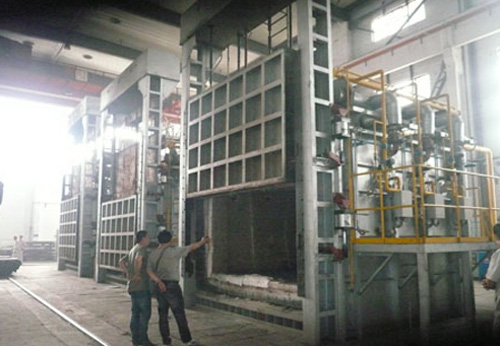
 The regenerative forging heating furnace adopts an independent regenerator or a regenerative burner, which can preheat the air or gas. It can be used in various types of heating furnaces and also in high temperature heat treatment furnaces.
The regenerative forging heating furnace adopts an independent regenerator or a regenerative burner, which can preheat the air or gas. It can be used in various types of heating furnaces and also in high temperature heat treatment furnaces. 
- The regenerative forging heating furnace adopts an independent regenerator or a regenerative burner, which can preheat the air or gas. It can be used in various types of heating furnaces and also in high temperature heat treatment furnaces.
Regenerative heating furnace for forged parts structure features:
- The regenerative forging heating furnace is essentially a combination of a high-efficiency regenerative heat exchanger and a conventional heating furnace, and is mainly composed of a heating furnace body, a regenerator, a reversing system, and a fuel, a supply air, and a smoke exhaust system.
- The regenerator is the main body of the flue gas waste heat recovery of the regenerative heating furnace. It is a chamber-like space filled with the regenerator and is part of the flue gas and air flow passage. In the heating furnace, the regenerators are always used in pairs, and one furnace can be used in pairs or in pairs or even dozens. In some large domestic heating furnaces, up to forty pairs are used.
- Advantages of regenerative waste heat recovery The furnace temperature is more uniform. Because the furnace temperature is evenly distributed, the heating quality is greatly improved, and the product qualification rate is greatly improved.
- The fuel selection range is more suitable for various fuels such as light oil, heavy oil, natural gas, and liquefied petroleum gas. Especially for low-calorie blast furnace gas and producer gas, it has a good preheating and combustion-supporting effect, which expands the application range of fuel. Therefore, the fuel consumption of the furnace is greatly reduced.
- For general large-scale heating furnaces, energy saving can be 25% to 30%; for heat treatment furnaces, energy saving can be 30% to 65%. The lower the amount of NOX generated by the traditional energy-saving technology, the higher the preheating temperature of the combustion air, the greater the NOx content in the flue gas; and the regenerative high-temperature air combustion technology, in the case of the preheating temperature of the combustion air up to 800 ° C, The amount of NOX produced in the furnace is greatly reduced.
- Since the regenerative combustion is dispersed combustion in a relatively low oxygen state, there is no flame center, and therefore, there are no conditions for generating a large amount of NOx. The low NOx content in the flue gas is conducive to environmental protection. Another benefit of low oxidation and low oxygen combustion of metal oxides is that it reduces the oxidative burnout of the heated metal. In addition, regenerative combustion can also increase the flame radiation intensity, enhance the radiation heat transfer, and increase the furnace output.

Jiangsu Jiuding Industrial Furnace Technology Co., Ltd. is a young enterprise with unique ideas on the design and manufacture of industrial furnaces and heat treatment furnaces.
To provide you with equipment design, process design, suitable for your heat treatment equipment purchase plan, according to your requirement.